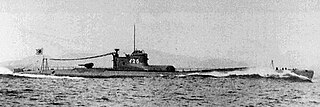
The Type AM submarine, also called I-13-class submarine was a pair of large, aircraft-carrying cruiser submarines built for the Imperial Japanese Navy (IJN) during World War II.

The Type A1 submarine, also called I-9-class submarine were a trio of aircraft-carrying cruiser submarines built for the Imperial Japanese Navy (IJN) during the 1930s. All three participated in the Pacific War and were lost.

The Ro-100-class submarine was a group of medium-sized coastal submarines built for the Imperial Japanese Navy (IJN) during World War II. The IJN official designation for this class was Ko type submarine or Senshō type submarine. They are also known as Type KS submarine. The type name was shortened to Sensuikan Ko-gata.
The Japanese submarine I-28 was one of 20 Type B cruiser submarines of the B1 sub-class built for the Imperial Japanese Navy (IJN) during the 1940s.

The Japanese submarine I-31 was one of 20 Type B cruiser submarines of the B1 sub-class built for the Imperial Japanese Navy (IJN) during the 1940s.
The Italian submarine Flutto was the name ship of her class of submarines built for the Royal Italian Navy during World War II. She obtained no successes during her short career, and was sunk by British ships during the Invasion of Sicily in 1943.
Ro-102 was an Imperial Japanese Navy Ro-100-class submarine. Completed and commissioned in November 1942, she served in World War II, operating in the Solomon Islands, Rabaul, and New Guinea areas. She disappeared in May 1943 during her third war patrol.
The Japanese submarine I-179 was a Kaidai type cruiser submarine of the KD7 sub-class built for the Imperial Japanese Navy (IJN) during the 1940s. She was lost with all hands when a valve was accidentally left open during her sea trials in July 1943. Her wreck was later salvaged and scrapped in 1957.

Domenico Millelire was one of four Balilla-class submarines built for the Regia Marina during the late 1920s.
Balilla was the lead ship of her class of four submarines built for the Regia Marina during the late 1920s.
Ro-35 was an Imperial Japanese Navy Kaichū type submarine, the lead unit of the K6 sub-class. Completed and commissioned in March 1943, she served in World War II and was sunk during her first war patrol in August 1943.
Ro-38 was an Imperial Japanese Navy Kaichū type submarine of the K6 sub-class. Completed and commissioned in July 1943, she served in World War II and was sunk in November 1943 during her first war patrol.
Ro-39 was an Imperial Japanese Navy Kaichū type submarine of the K6 sub-class. Completed and commissioned in September 1943, she served in World War II and was sunk in February 1944 during her first war patrol.
Ro-40 was an Imperial Japanese Navy Kaichū type submarine of the K6 sub-class. Completed and commissioned in September 1943, she served in World War II and was sunk in February 1944 during her first war patrol.
Ro-47 was an Imperial Japanese Navy Kaichū type submarine of the K6 sub-class. Completed and commissioned in January 1944, she served in World War II in operations related to the Mariana and Palau Islands campaign. She was sunk in September 1944 during her second war patrol.
The second Ro-55 was an Imperial Japanese Navy Kaichū type submarine of the K6 sub-class. Completed and commissioned in September 1944, she served in World War II and was sunk during her first war patrol in February 1945.
The second Ro-56 was an Imperial Japanese Navy Kaichū type submarine of the K6 sub-class. Completed and commissioned in November 1944, she served in World War II and was sunk during her first war patrol in April 1945.
Ro-107 was an Imperial Japanese Navy Ro-100-class submarine. Completed and commissioned in December 1942, she served in World War II, operating in the Solomon Islands. She disappeared in July 1943 during her third war patrol.
Ro-114 was an Imperial Japanese Navy Ro-100-class submarine. Completed and commissioned in November 1943, she served in World War II and was sunk in June 1944 during her first war patrol.
Ro-117 was an Imperial Japanese Navy Ro-100-class submarine. Completed and commissioned in January 1944, she served in World War II and was sunk in June 1944 during her second war patrol.





